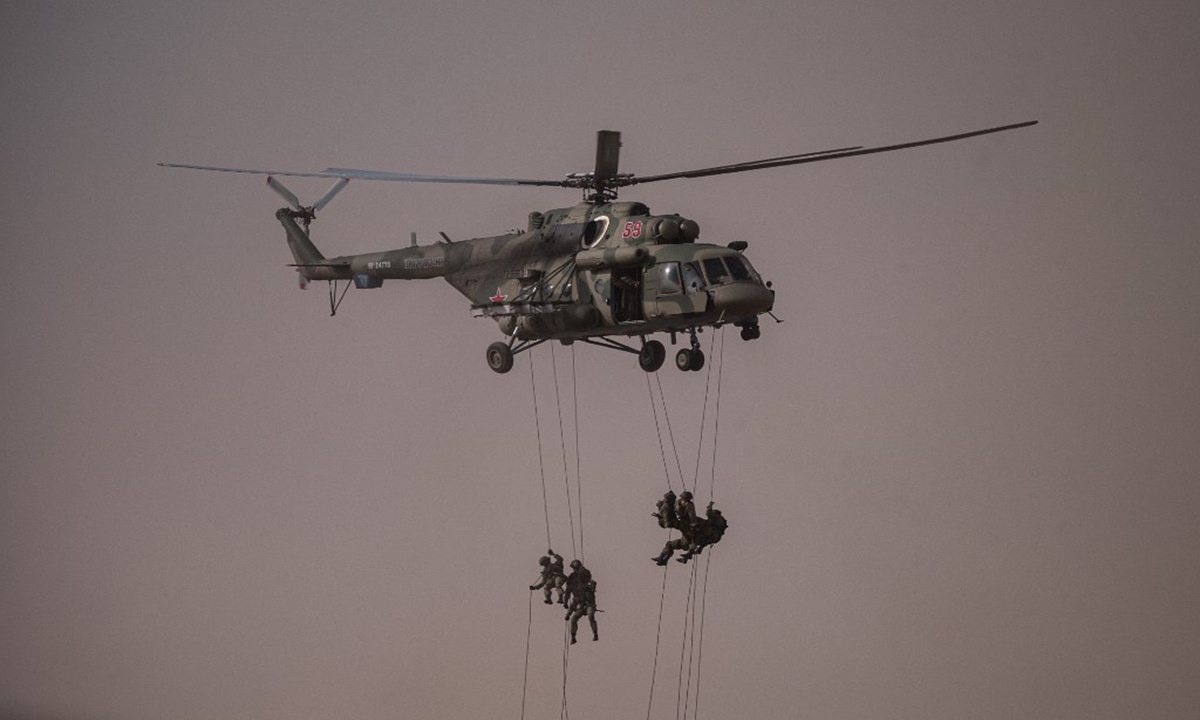
Russian servicemen take part in military exercises at the Kapustin Yar range in Astrakhan region, Southern Russia on Friday during the "Caucasus-2020" military drills gathering China, Iran, Pakistan and Myanmar troops, along with ex-Soviet Armenia, Azerbaijan and Belarus. (Photo: AFP)
The Kavkaz - Russian for "Caucasus" - 2020 military drills concluded on Saturday, with neighboring countries in Russia's Southern Military District and in the Black and Caspian Seas. Troops from several countries including China, Pakistan and Iran participated in the Caucasus 2020 drills.
Russian General Staff head General Valery Gerasimov said on Friday that the Caucasus 2020 drills were prepared and conducted with maximum transparency for third countries. Yet some still express doubt that the locations of the drills were sensitive. Some said the drills were offensive exercises targeting Ukraine and NATO.
There is a military tactic called "defensive counterattack." The main purpose of the Caucasus 2020 military drills were to smash potential color revolutions and react to counter-terrorism. The drills not only aim at protecting relevant countries from enemies, but also target terrorist forces wherever they lurk. Actively striking out allows forces to prepare to avoid greater damage to the country.
Any military exercise, although defensive in nature, is ultimately offensive. A good offense turns out to be the best defense. The Caucasus 2020 exercises follow such a basic principle as well. Strengthening counter-terrorism requires both domestic and external moves.
During the Caucasus 2020 drills, the Chinese People's Liberation Army (PLA) used a lot of Russian weapons. This attracted attention from the outside world. In fact, the mutual use of weapons and learning from each other's advantages are an important element to strengthen military capabilities. By exchanging weapons and equipment, the two sides were able to learn from each other's advanced technology.
If possible, the PLA might also exchange weapons with other countries' military as well. This benefits the PLA. It helps boost the technical performance of our weapons. We should not stick to a few types of weapons and equipment.
China sent troops and light combat vehicles by Y-20 military transport aircraft to southern Russia for the Caucasus-2020 exercises. It was the second time the Y-20 transport aircraft has arrived in Russia since Chinese troops took part in this year's Victory Day parade at the Red Square in May.
The Chinese military does not have to demonstrate its Y-20 transport aircraft, nor its ability to bear weapons. It chose to hone its long-distance delivery abilities, using the opportunities and occasions to strengthen this capability. Recently, Y-20 transport aircraft were also sent to South Korea to bring back the remains of Chinese soldiers who died in the Korean War. These actions can be construed as actual combat training. All of these actions are manifestations of practicing actual combat. The frequent use of such equipment allows the PLA to adapt to more unfamiliar airspace and environments. This is very valuable to China.
Military exchanges and cooperation between China and Russia has been relatively intensive in recent years. For example, China and Russia held naval drills in the Mediterranean Sea in 2015. In 2017, China and Russia held joint naval drill in the Baltic Sea. Russia has also held many joint naval drills with China in the territorial waters around China. These include the East China Sea, the Yellow Sea, and the South China Sea. Joint military exercises in maritime areas of mutual concern greatly enhance each other's military capabilities.
In the Caucasus-2020 exercises, Iran took part in naval drills, while China participated in the land drill. Iran, China and Russia are all countries that the US considers to be on different sides. They are all subject to US sanctions in one way or another. Besides, China, Iran and Russia all face disruptions and harassment from terrorist forces.
Objectively speaking, these exercises are an important demonstration of strengthening military ties between several countries in traditional and non-traditional security fields. In this light, there is no case for coalescing or forming military alliances against the US or NATO. The core idea of such military drills is to strengthen mutual cooperation and boost our own military capabilities. After all, no country can rely on others to safeguard its core interests. Everyone ultimately is on its own.
The author is a Chinese military expert and commentator.


